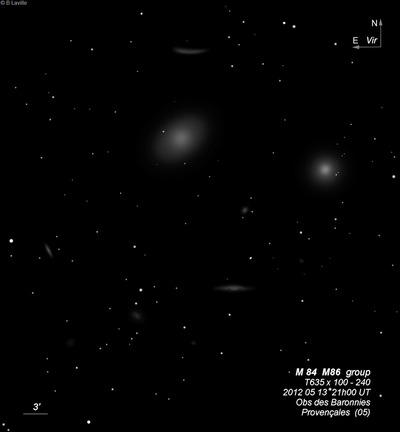
Charles Messier is credited with the discovery of M84 = NGC 4374 = h1237 on 18 Mar 1781, along with M86, and described a "Nebula without star, in Virgo; the center it is a bit brilliant, surrounded with a slight nebulosity: its brightness and its appearance resemble that of those in this Catalog, No.s 59 & 60." But Wolfgang Steinicke recently found (email Oct '16) that Johann Gottfried Koehler made the original discovery on 5 May 1779 using a Dolland refractor of 6-ft focal length. WH only recorded it on sweep 199 from 17 Apr 1784 and simply noted "B. Is No. 84 of the Connoissance des Temps." JH also recorded it only a single sweep, noting "vB; R; psbM; 60"; r."
300/350mm - 13.1" (5/14/83): very bright, very bright core. Located in the core of the Virgo cluster.
400/500mm - 17.5" (4/25/87): very bright, moderately large, almost round, very bright core, very small bright nucleus, halo gradually fades into background sky so there is no sharp edge. Nearly an identical twin of M86 17' ENE but rounder.
600/800mm - 24" (4/28/14): extremely bright, large, slightly elongated, ~4'x3.5', sharply concentrated with a very intense core that increases gradually to a nonstellar nucleus. The large halo gradually fades out. A mag 14.5 star is superimposed on the SW side of the halo, 1.2' from center. In the 23' field (at 260x) is M86 17' ENE, NGC 4438 17' SE, NGC 4387 10' ESE, IC 3303 11' SSE
Notes by Steve Gottlieb